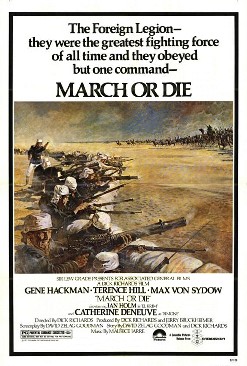Plot
Major William Foster, an American commander in the French Foreign Legion, is haunted by memories of the Great War which has just ended. He suffers from alcoholism and his only friend is his faithful sergeant, Triand.
Foster takes command of a legion and takes it to Rif in Morocco to re-establish French authority over the Bedouin and Berber tribes revolting against French rule. Foster is also ordered to escort archaeologists from the Louvre, who are excavating an ancient city near Erfoud, the final resting place of a Berber saint known to the French as "the Angel of the Desert". Foster was the only French officer alive who served in Morocco before the war and had helped develop diplomatic ties with the tribes by negotiating with El Krim, their de facto leader. One condition of peace was that the French cease all archaeological expeditions without the tribes' approval.
Among Foster's fresh recruits are "the Gypsy" Marco Segrain, a charming jewel thief famous for a three-year crime spree on the Riviera before getting arrested, the Russian giant Ivan, formerly a bodyguard for the deposed Russian imperial family; "Top Hat" François Gilbert, a fashionable musician who lacks the physical traits needed in a soldier; and Frederick Hastings, a romantic English aristocrat who longs for the days of the Great War.
The four friends are disillusioned by the harsh life of the Legion and the men fight as they travel to Morocco. Foster discipline them harshly, especially the insubordinate Marco who charms one of the accompanying archaeologists, Madame Picard. Their train is intercepted by tribesmen. El Krim greets his old friend Foster and declares Morocco belongs to his people and no longer welcome the French. El Krim reveals he has been torturing two French archaeologists captured at an earlier dig; their eyes and tongues have been gouged out and he asks Foster to turn back and take this "gift" with them to the Premier of France. Foster shoots the two archaeologists to end their suffering, one is later revealed to be Madame Picard's father, and continues to a French fortress. Foster puts the men through unforgiving training exercises. Top Hat, left to die after dropping out of a march, returns to camp and commits suicide to evade further abuse.
Hastings is kidnapped from guard duty at the dig site and is tortured to death by a tribal raider. El Krim excuses the raider as being overzealous, and Marco kills the raider in retaliation. Foster tells El Krim that Marco was also overzealous and El Krim accepts it.
When the tomb of the Angel of the Desert is found, Foster offers her golden sarcophagus to El Krim as a peace token, but El Krim rallies the warriors of the Bedouin tribes to slaughter the Europeans. The well-trained Legionaries kill hundreds of tribesmen before being overrun. Ivan is killed, and Marco single-handedly stops the tribesmen from outflanking them. When Foster is shot dead, El Krim ends the fighting, telling the surviving legionnaires to take Foster and their dead back home and "tell the world what happened".
The television version ends with Marco taking up Picard's offer to desert with her. The theatrical release ends with Marco, promoted for bravery, staying behind to train more recruits and welcoming them by reiterating Foster's earlier warning: "If the Legion doesn't get you, the desert will. If the desert doesn't, the Arabs will. And if the Arabs don't, then I will. I don't know which is worse."
Additional scenes
In the television version, several scenes were used that were not included in the theatrical or in the video/DVD versions of the film. One pivotal extra scene occurs after the excavation work has commenced, and two of the legionaries, both of them German recruits, are found to have deserted. The sadistic second-in-command of the company, Fontaine, and his equally vicious crony, the corporal, lead a patrol to capture them. They catch up with the two Germans, and Fontaine orders the patrol to shoot them. The noise attracts a large group of Bedouin tribesmen, and disregarding the warnings from his men, Fontaine orders his men to open fire, igniting a battle. The corporal is shot dead, and Fontaine breaks down in fear and kills himself. Marco displays his courage and natural flair for leadership by rallying the survivors of the patrol and successfully beating off the attackers.
In the video release, that scene was omitted, but brief shots of Fontaine and the corporal were taken from this scene and edited into the climactic battle at the digging site, which makes it appear that both men died there instead.
Production
Dick Richards had been interested in the French Foreign Legion ever since he found out a friend of his uncle's had joined the legion. [6]
Most of the finance was provided by Lew Grade's ITC Company on the basis of Terence Hill's popularity. It was Hill's second film aimed at the American market. [2]
Filming started 23 August 1976. [7] It was mostly shot in Spain. [2]
Gene Hackman was injured during filming after he was thrown off a horse. [8] That caused filming to be suspended. [2] Columbia agreed to distribute in the US only because it wanted to distribute Grade's The Eagle Has Landed . [9] In most markets, March or Die played theatres in a double-bill with Eagle.
